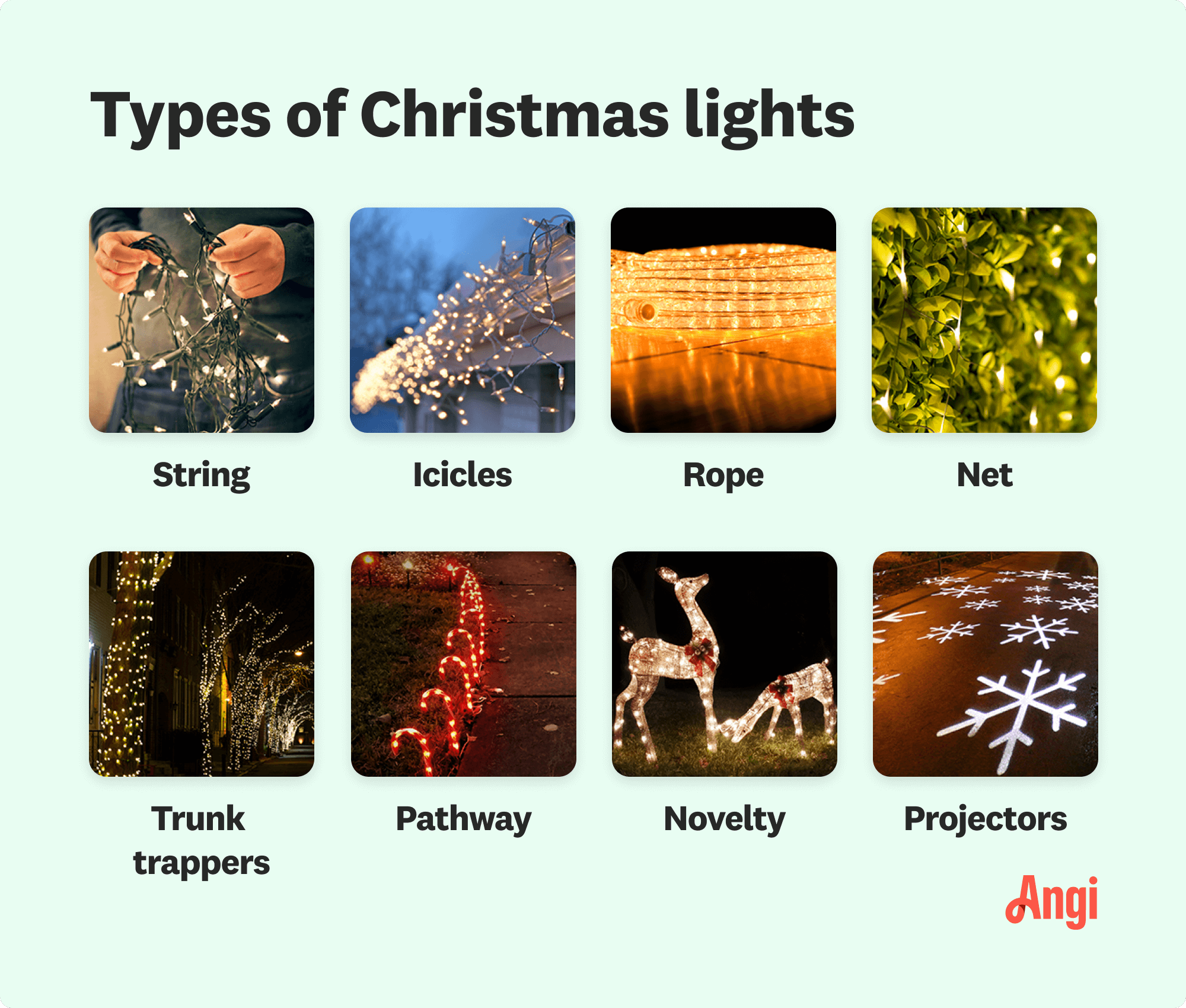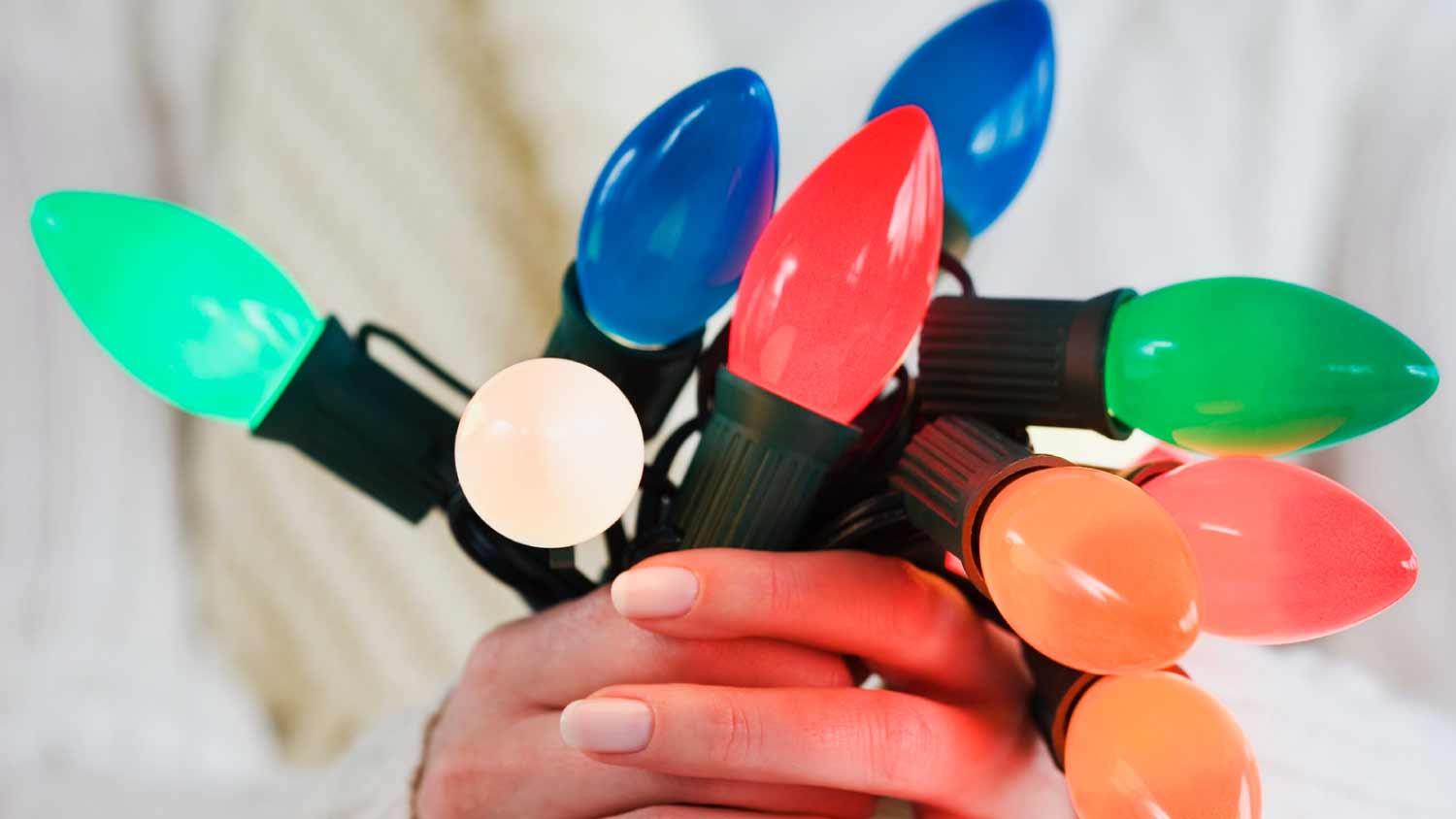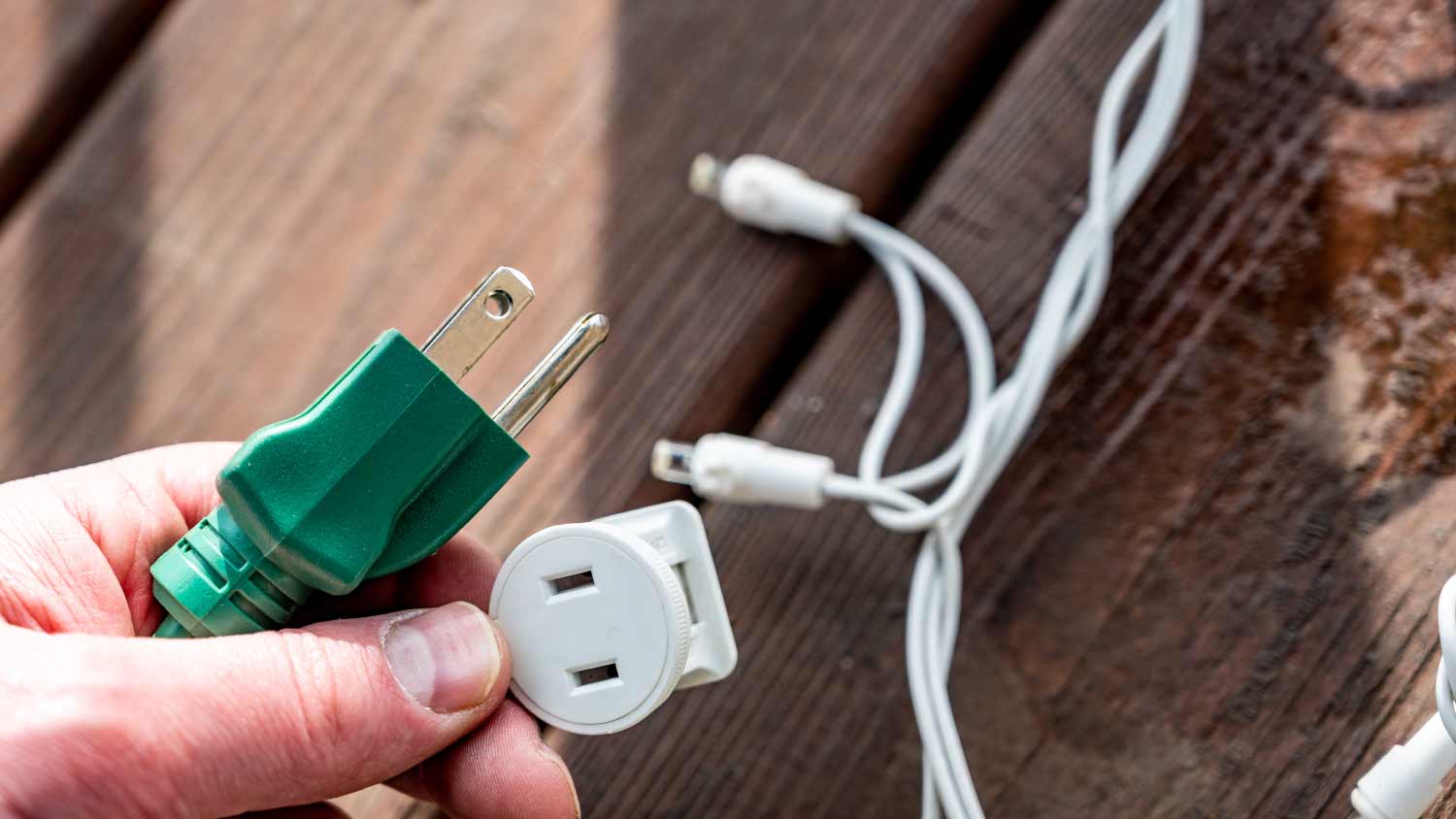
If you're dreaming of rocking around your—professionally decorated—tree this season, this is how much a Christmas tree decorating service will cost you.
Be crowned the most festive home on the block this holiday season


Hire a pro holiday decorator to identify the best types of Christmas lights for you based on your unique budget, home, and aesthetic goals.
String lights, icicles, and rope lights are the most popular options and are easy to hang on your own.
Consider pathway lights if your home has a long driveway or winding path, as they can increase your home’s safety and boost its curb appeal.
Projectors are a solid choice if you don’t have a lot of free time and want to quickly decorate your home for Christmas.
As you gear up for the winter holiday season, you have to make a very important decision: Which type of Christmas lights will you choose to illuminate your home?
Whether you're a Christmas light connoisseur or a first-time decorator, it’s helpful to know your lighting options. From bulb types to sizes to color choices, read on to learn everything you need to know about the various types of Christmas lights. If you’re still on the fence, consider hiring a local holiday light installer who can advise you on the best lighting options for your home.
| Brightness | Less bright to not overpower rooms | Brighter for visibility |
| Durability | Suitable for indoor conditions | More durable to withstand elements |
| Power Source | Household outlets | May require extra long cords and ground stakes |
| Length and Spacing | Shorter length, closer bulb spacing | Longer length, wider bulb spacing |
| Color Options | Wide range of colors with dimmers and timers | Wide range of options, with more wiring and connections |
| Installation | Adhesive or hooks | May require additional tools, clips, or brackets |
| Energy Efficiency | LED options available | Options available, but designed for maximum brightness |
If you already own lights and may have gotten strands mixed up or have lost the original boxes, you can check the light tags to find the information you need. Avoid cutting off tags on your Christmas lights for this purpose. You may also need this information in case you need to know how to fix your Christmas lights.

You have two options for Christmas light bulbs: LED or incandescent. Try to avoid mixing bulb types as you will notice a difference in appearance, altering the look of your display.
| Light Type | Key Differences |
|---|---|
| LED | Longer Lifespan; Higher Cost; Brighter Look |
| Incandescent | Shorter Lifespan; Lower Cost; Warm Glow |
LED lights are an energy-efficient bulb option with a longer lifespan than incandescent bulbs. While this type of bulb is more expensive, the cost is outweighed by its longevity. The initial investment may be higher, but you won't need to repurchase lights as frequently as incandescent bulbs.
Another benefit of LED Christmas lights is the display, which features a brighter appearance than incandescent. The lights also feel cooler in comparison, and that’s part of what prolongs the life of the bulbs.
Incandescent lights are a less expensive Christmas light option and are considered a classic bulb type. These light bulbs display a warm glow, which is why many people use this light during the Christmas season. However, incandescent bulbs are less durable compared to LED lights and burn out more quickly, requiring more frequent repurchasing. The bulbs can also be hot to the touch.


The type of lights you choose depends on factors like how much time you want to invest in the setup and the overall look you’re after.
The most popular option for Christmas lights is string lights, which groups multiple bulbs on one string or wire. The string makes decorating easy as you can wrap a light strand around a Christmas tree or clip the strand on the roofline. Make sure you practice proper holiday lighting safety when hanging lights yourself.
Another popular outdoor Christmas light option is icicle lights. This type of light was created to portray the look of real icicles for a wintery appearance. The lights dangle from strands of varying lengths, with the icy bulbs attached.
Rope lights are clear tubes with internal lights and can be used year-round for additional lighting. These lights are frequently used to wrap around banisters, frame doorways or windows, or use on cabinets.
Net lights are a convenient solution to lighting foliage in your yard, such as bushes or trees. Net lights feature multiple lights on a string in a grid design that you can throw over foliage for a no-muss, no-fuss lighting display.
Trunk trappers are similar to net lights because they feature a lighted grid design that you can wrap around tree trunks for a magical look. If you have large trees in your yard, this is a safer solution for lighting your tree than using a ladder to decorate the tallest branches. Be sure to follow ladder safety guidelines when decorating your trees.
Consider lighting the way with stunning pathway lights if your home features a long, winding path or driveway. This lighting option can help enhance your outdoor Christmas display, plus they are easy to install. You can choose from many different colors, but if you choose a basic warm or cool white color, you could use the lights all year round as an additional lighting choice to increase home safety.
Step outside the box with your Christmas light display and use novelty or shaped lights. Choose string lights that feature a shape, such as snowflakes or bells, or add novelty displays such as a reindeer or Santa Claus to your yard. These lighting options are a wonderful way to add a focal point to your display.
Another type of lighting display that's grown increasingly popular over the past decade is projectors. If you can't fit hanging lights into your busy schedule, a projector is a great way to get your home into the holiday spirit quickly. You can place projectors on your lawn facing your home or garage to display a fun, customized holiday image.

The final choice you need to make with your Christmas light display is which color you will choose for the light bulbs.
The quintessential Christmas light color is warm white. These lights’ traditional, cozy appearance is a fan favorite for their softness and glow. Some people choose to only feature warm white in their display without the use of bright colors. They look especially festive wrapped around a Christmas tree.
Cool white is another popular light color for homeowners who want to maintain a more traditional holiday light display. The brilliance of the cool white has a more modern appearance, and it’s reminiscent of the chilling winter season, making it a popular color choice for icicle lights.
For a winter wonderland look, the color blue makes a fun Christmas light choice. Blue lights can elevate the traditional red-and-white look, or you can try mixing them in with bolder light colors, like purple or yellow.
Red is one of the most common colors associated with Christmas, and homeowners love to include it in their light displays. Many novelty and shape lights feature the color red in the design, especially for novelties such as Santa Claus or mistletoe.
You can't discuss Christmas light colors without including the quintessential color green. Similar to red, green is frequently associated with the season and is often used in decorations from Christmas trees to wreaths.
Whereas some homeowners want to maintain a simple appearance with their light display, others want to go bold with a burst of color. Multicolored lights feature a combination of colors, including red, orange, yellow, green, blue, and purple.
Color-changing Christmas lights create an eye-catching and dynamic element to a holiday lighting display. These versatile LED lights are designed to transition smoothly between a spectrum of vibrant colors, creating a mesmerizing light show.
Choosing the right color of Christmas lights comes down to the overall theme of your decor and the mood you want to convey. Classic white lights, whether warm white for a cozy feel or cool white for a modern touch, provide timeless elegance and work well with almost any décor. Blue lights are perfect for an icy look, but they can also feel cool and calming. For a traditional and festive look, consider multi-colored lights, which add a playful and cheery vibe to your decorations. If you’re still not sure, or if you want versatility, opt for color-changing LED lights that you can switch up with the seasons.

There are several bulb sizes to choose from to match your vision for your display, whether you're looking for something simple and delicate or a display that's bold and extravagant.
Mini Christmas lights are a very popular option during the holiday season for lighting Christmas trees, outdoor bushes or trees, or lining doorways or windows. Mini lights are great for indoor and outdoor use.
C3 is the smallest of the C Series light bulbs. C Series bulbs refer to the shape of the bulbs, which is a cone shape. Measuring 1/2 inch in diameter and 4/5 inch in height, the C3 bulb is a great option for light outdoor foliage such as bushes and trees.
Considered the traditional Christmas light size, C6 bulbs measure 3/4 inch in diameter and 1 1/8 inch in height. This bulb is the first in the C Series to resemble a strawberry shape, with the larger sizes continuing that shape but increasing in size.
C7 bulbs are slightly larger than C6 bulbs but feature a more rounded appearance. The C7 bulb measures 1 inch in diameter and 1 1/2 inches tall.
The largest of the C Series bulbs, C9 measures 1 1/4 inches in diameter and 2 1/2 inches in height. These bulbs are great for lighting up wide, open spaces as they feature nearly double the wattage of size C7 bulbs.
5mm LED lights are small in size but pack a powerful punch in terms of illumination. These wide-angle lights are a great option for wrapping branches and tree trunks.
If you're looking to break away from the traditional cone-shaped Christmas tree lights, G12 lights feature a round globe shape for a brilliant glow. The bulbs measure 7/16 inch in diameter and 1/2 inch in height. G12 bulbs are great for use in both indoor and outdoor decorating.

Christmas lights powered by electricity are a common choice, but some lights are also available with battery operation or solar power. Check out the various Christmas light power sources.
When you think of Christmas lights, you likely think of the type with a plug-in electrical source. You will need access to an outdoor power source to operate your plug-in Christmas lights. This light type may require the use of an extension cord, so make sure you have an outdoor-safe option. The benefit of plug-in Christmas lights is that you don't need to worry about the power source running out as you would with battery-operated or solar lights.
If you're looking to light an area located away from a power source, you can use battery-powered lights for your lavish light display. Battery-operated lights are great for placing lights in areas where plug-in lights aren't possible or would pose a safety hazard, such as inside a Christmas wreath or other door decor.
While battery-powered lights may have an aesthetic appeal, it can be cumbersome to switch out the batteries to keep the lights lit. The battery life span depends on the type of light bulb, length of the strands, and the battery power. You should also consider the additional cost of supplying batteries for the lights, which can add up if you have a large display.
If you're looking for a more sustainable option for your Christmas light display, look no further than solar-powered lights. The cost of solar-powered lights is comparable to plug-in lights, and you can help reduce your environmental footprint this holiday season. Plus, most of the Christmas lights come with solar panels included.
The tricky thing about solar lights involves keeping up with the weather changes. If you hang them in a shaded area or experience gloomy weather, there may not be enough sunlight to power the lights through the night.
Not sure how many light strands to purchase? Here’s what to consider when doing your holiday light shopping.
As you’re shopping for the right types of Christmas lights, be sure to consider bulb spacing and string length. Some lights have bulbs spaced closely together, creating a bright and radiant glow, while others have larger gaps between bulbs for a more understated look. Longer strings with smaller spacing work well for draping along the tree branches, while shorter strands with tighter spacing are ideal for wrapping around smaller items or shaping into intricate designs.
When decorating outdoor trees, opt for lights rated for outdoor use to ensure durability against the elements. Measure the height and circumference of the tree to determine the number of strands you'll need. You’ll also want to account for how much space you want between each string of lights. The most common spacing for wrapping outdoor trees is 6 inches for wrapping trunks and branches, with about 2 to 3 inches between each string.
It’s best to divide the height of the tree by the string spacing, then multiply that number by the total trunk circumference to figure out the string length you need. For example, if the height of your tree is 4 feet and you want 3 inches of space between each strand, and the circumference of the trunk is 2 feet, your calculations will look like this:
4-foot tree (48 inches)/3 inches spacing = 16 x 2-foot circumference = 32 feet of strings
To calculate the length of strings you need for branches, follow the below example:
3-foot long branch / 3 inches spacing = 12 x 6-inch circumference = 6 feet of lighting per branch
Add up the number of branches you want to wrap, then add that total to your trunk total for an estimation of how many strands of lights to buy.
A general rule for wrapping Christmas trees is to use a minimum of 100 lights per vertical foot. So, if you have a 7-foot Christmas tree, you’ll need at least 700 lights to wrap the entire thing effectively. Consider 4-inch bulb spacing to achieve maximum lighting with the least amount of strings shown for a cleaner look.
To minimize the energy usage of your holiday lighting display, be sure to opt for LED Christmas lights. Look for products with the Energy Star label—these lights meet strict energy efficiency guidelines and are designed to consume less power. If you live in an area with plenty of sunshine, you can even consider solar Christmas lights to forgo energy expenses altogether.
Another energy-saving must is setting your Christmas lights on a timer. Not only will this limit the cost on your electric bill, but it will save you the trip to your frigid garage to shut off your lights at the end of the night.
Careful planning will help streamline the process of installing your Christmas lights and minimize any headaches along the way. Be sure to measure the areas where you intend to hang or wrap lights beforehand, whether it's the eaves of your house, the branches of a tree, or the edges of a window. Planning your layout in advance will help ensure you have the correct number of lights and strands required. Again, if in doubt, purchase more and return whatever you don’t use.
Before you begin hanging your Christmas lights, ensure you have all the necessary supplies, including the lights, extension cords, clips, hooks, and a reliable ladder if needed. Test all your Christmas lights to ensure they are in working order, and replace any burnt-out bulbs or damaged strands.
Safety should be a top priority when installing Christmas lights to minimize the risk of accidents and electrical fires. Here are some key safety tips to keep in mind this holiday season:
For outdoor displays, use extension cords and power strips rated for outdoor use.
Thoroughly inspect lights and cords for any signs of damage, such as frayed wires, exposed conductors, or broken bulbs.
Do not overload electrical circuits by connecting too many lights to a single outlet.
Protect outdoor outlets with weatherproof covers and use ground fault circuit interrupters (GFCIs).
When using a ladder, ensure it's on stable ground, and always have someone spot you.
Use the appropriate clips, fasteners, or hooks to secure lights—do not use metal nails or anything that could damage the wiring.
After the holiday season, store your lights in a cool, dry place to prevent damage and ensure they're ready for use next year.
From average costs to expert advice, get all the answers you need to get your job done.

If you're dreaming of rocking around your—professionally decorated—tree this season, this is how much a Christmas tree decorating service will cost you.

How much does a Christmas decorating service cost? Turn your home into a winter wonderland this year—here are holiday decorating service prices.

Keep your holiday season merry and bright by learning how to make Christmas lights blink. This cost-efficient guide shares how to make lights twinkle.

Can you put Christmas lights on the ground? Yes, but it’s essential to use the proper supplies and precautions. Find out more with this helpful guide.

Learn how to hang Christmas lights on gutters with or without your home's gutter guards in place and with or without a ladder. Follow our guide to learn more.

It’s time to deck your halls. From choosing the right roof clips to step-by-step instructions, learn how to hang Christmas lights on a roof in this guide.